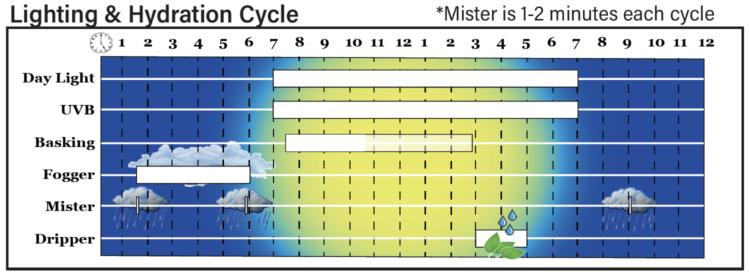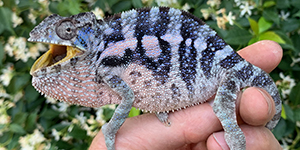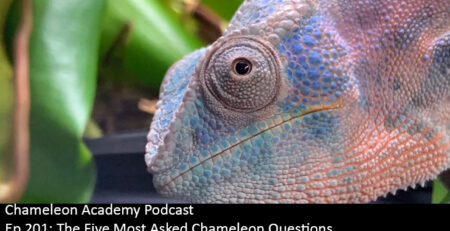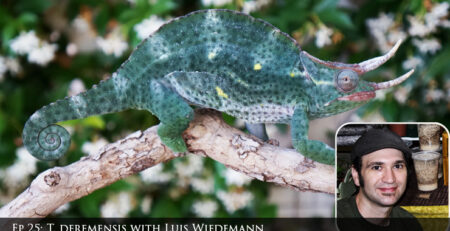Chameleon Environment: Humidity
Humidity is not necessarily a controversial topic as much as it is has been overlooked for so long as an important husbandry consideration. I feel much of this has to do with the chameleon community’s concentration on screen cages. Screen cages are exceptionally difficult to have any sort of control over humidity. The best you can do is use a fogger which produces a narrow cone of fog for the chameleon to find if it wants to sleep in a humid environment. And, considering how many chameleons somehow figure out where this cone of fog will be and select that place to sleep it is plain to see that they like humid nights. But the community has ignored this environmental parameter to its detriment.
With the growing shift to the naturalistic hydration method which employs cool, high humidity nights with dryer, warmer days, the awareness of the benefits of purposefully creating a humidity plan in our chameleon’s environment is spreading rapidly.
But since this is a parameter in transition in the community you will still find the day and night change in humidity conditions only on the more progressive care sheets. As humidity is either an omission or a single value in most care sheets, you will not find much in the way of conflict amongst the breeders and social media folk if you go with the naturalistic method. The conflict will arise if you start switching your caging away from screen cages to hybrid cages so you can effectively control your humidity. Humidity is a parameter which has not been given much attention before, but is so tied into other aspects of husbandry that taking it seriously affects caging, misting, and heating.
Humidity has been a sleeper parameter for so long because the benefits have been difficult to detect directly. The main benefit is that the chameleon stays hydrated during the night and does not wake up dehydrated. As we humans normally think of hydration as only the drinking action we can see, we have focused on daytime hydration. So we have disregarded the benefits of breathing humid air because we have made up with it by misting multiple times during the day and taking comfort in seeing the drinking action. By taking a step back and implementing cool, high humidity nights, we are seeing less need for daytime drinking. This is because the chameleons do not wake up as dehydrated.
Conclusion
The chameleon community has made low humidity husbandry work by subsidizing it with misting systems. While it has proved to be effective, I encourage you to give an increased focus on providing the humidity cycles that match the chameleon’s natural conditions. Our goal in chameleon husbandry is to give them the best life we can. The more of our conditions they thrive in rather than tolerate the healthier they can be. Focusing in on humidity is a significant change in husbandry approach and requires re-writing things many of us have done for decades. But, this one is worth it. I have seen the changes it makes in my chameleons’ general hydration state and I can feel good about getting behind this change in chameleon husbandry.
Back to the Chameleon Question Hub!
Click here to go back to the Chameleon Question Hub to review more questions!














